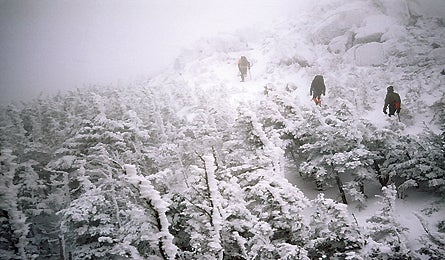Beginners Guide to Winter Camping

Yo campers!
Hangin’ with my relatives for the holidays has me fat, happy…and constantly looking out the window thinking about nights in the winter-silenced woods. So here’s a checklist for those of you who’ve thought about camping in the chill season, but haven’t tried it yet.
Preparation:
For your first camp-out, pick a scenic and sheltered destination that’s not far from retreat. You don’t need to go any farther than land management regulations or road noise require. If things go wrong, you can bail.
Choose a location with available firewood. You may not want a fire, but that way one is available if needed.
Camp near open water if possible, so you don’t have to spend all your time melting snow. If you’ll need to melt snow, plan on using three times the fuel you would for normal summer camping.
Know the weather forecast before you go. Don’t get surprised by sudden cold, storm, wind, or even a thaw that will make for soaking wet conditions.
Gear:
Dress in layers, and have the gear to overdress. You’ll need more clothes than you would for day-long activities like skiing.
Make sure your sleeping bag will suffice for long, cold nights. If you don’t have a winter bag, take two 3-season bags and nest one inside the other. Check the combination at home for fit and interior space.
Your boots need to be warm and waterproof. If you just own light hikers, go buy a cheap pair of snowmobile/moon boots. Support is less important than warmth here. Make sure they fit well and are durable enough for your trip.
Don’t cram extra socks into your boots unless there’s plenty of room for them. Tight-fitting boots will cut off circulation rather than keeping your feet warm.
Many three-season tents are perfectly adequate unless you expect heavy snow or high winds.
White gas stoves are best for winter, but in most conditions alcohol or canister stoves work fine. For cartridge stoves, avoid 80/20 butane/propane canisters (use isobutane), and warm cartridges in your sleeping bag or parka before firing up.
Hats and handwear are important. Choose a thick, warm hat. Mittens are more versatile than gloves, just pull them off briefly for dexterity needs.
Don’t forget sunglasses and sunscreen. Reflective snow can cook you, especially from late February on.
Bring a good headlamp with fresh batteries. You’ll want lots of light to deal with long nighttime hours.
On Your Hike:
If the snow is shallower than about one foot, don’t worry about skis or snowshoes. Keep it simple. You’ll want gaiters though.
Turn around frequently to survey your route, so you’ll recognize it more easily on the way out, should snow or wind obscure your tracks. (A good idea in all seasons).
It’s easier to stay warm than it is to re-warm. Don’t let yourself get chilled, or sweaty. Anticipate upcoming temperature and layering changes to stay ahead of them. For example, it’s smarter to layer up just before reaching a windy ridge top than it is to top out, get chilled, and then fight against the wind while layering up.
Don’t forget to drink. It’s easy to get dehydrated in winter.
You need calories to stay warm, so don’t let yourself get hungry, but don’t overdo it either.
At Camp:
Put on all your warm clothes immediately upon arrival. Preserve the heat you generated on the hike in.
When camping on snow, stomp out a tent platform immediately using skis, snowshoes or just boots and a shovel. Make it larger than you think you’ll need, and be fanatic about packing it flat. Then let it set up hard before trying to pitch your tent.
Set up camp so you can cook food and drinks from your sleeping bag. If you cook in a vestibule, prime your stove outside the tent, then bring it in. Allow for plenty of ventilation.
Plan to spend lots of bag time, so have an activity to pass the dark hours, like a book, good conversation, games, or simple but multi-course meals.
If you start to chill, don’t just sit there in misery. Go on a walk, do sit-ups or deep knee bends. Generate metabolic heat.
Hot water bottles also work miracles for chilled campers. Placed close to your body underneath clothes or bag, they’ll pump heat for about six hours.
Mornings are the toughest time for winter camping. Temps are usually coldest just before dawn, and you’ll emerge from your bag inactive and easily chilled. Get up and go for a walk. Then come back and break camp once you’ve warmed up.
Got your own favorite winter camping tips? Cough ’em up in the comments section.
–Steve Howe
(Photo by Mark Carroll)